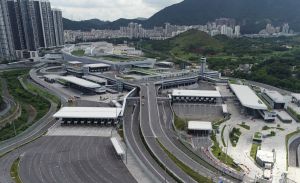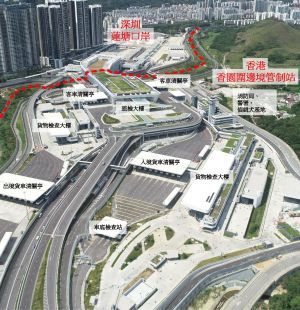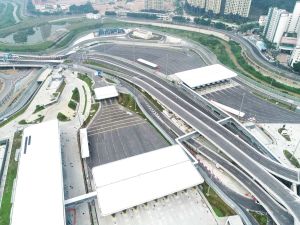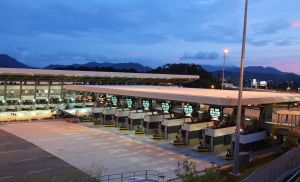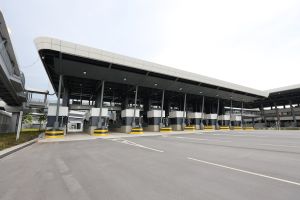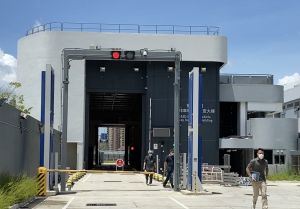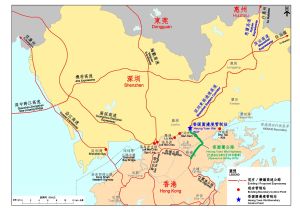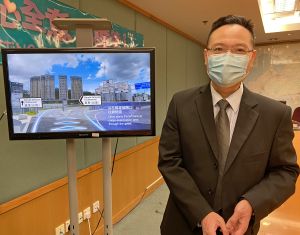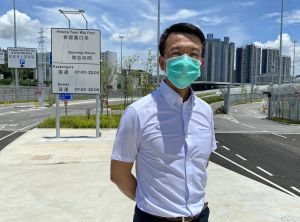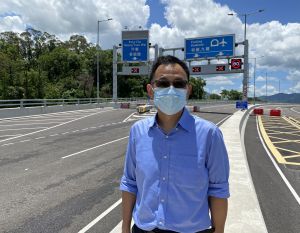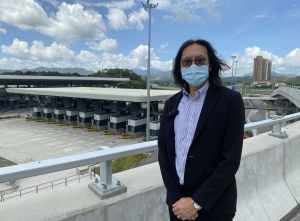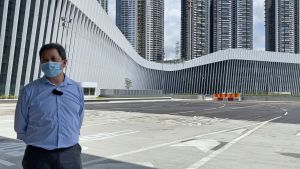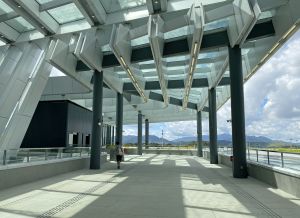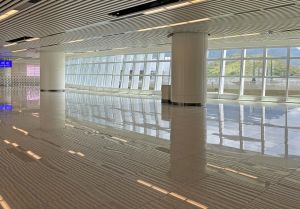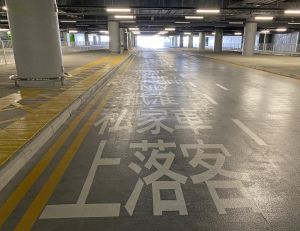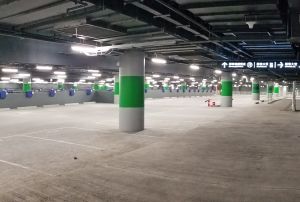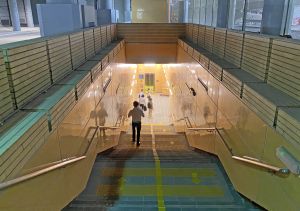Cargo clearance facilities at Heung Yuen Wai Boundary Control Point to open first
|
Infrastructure facilities are important and crucial to what Hong Kong has achieved today. The soon-to-be commissioned Liantang /Heung Yuen Wai Boundary Control Point (BCP), which is the seventh land-based boundary control point located at the boundary between Hong Kong and Shenzhen, is of no exception. In view of the COVID-19 epidemic, both Guangdong and Hong Kong have agreed to open first the cargo clearance facilities for use by cross-boundary goods vehicles from 4pm this Wednesday to further facilitate freight transport. At the initial stage of the commissioning of the BCP, its operating hours for cargo clearance will be from 7am to 10pm daily. This time, I have invited a colleague of the Transport Department (TD) to talk about the feeder services of the new BCP, whereas colleagues of the Civil Engineering and Development Department (CEDD) and the Architectural Services Department (ArchSD) will share with us the functions of the new BCP and the design features of the Passenger Terminal Building respectively. Field testing smoothly conducted by the freight industry The new BCP in Hong Kong is named Heung Yuen Wai BCP for its proximity to Heung Yuen Wai, and Liantang Port in Shenzhen is named as such for its proximity to Liantang. Chief Traffic Engineer/New Territories West of the TD, Mr CHOW Bing-kay, says that motorists can use the Heung Yuen Wai Highway commissioned last year to travel directly to the BCP via interchanges at Fanling Highway, Sha Tau Kok Road, Ping Yeung and Lin Ma Hang Road. There are traffic aids along Heung Yuen Wai Highway to remind drivers of goods vehicles driving along the designated traffic lane on the left side for access to the outbound goods vehicles clearance area. The TD has uploaded relevant driving guides to its website and the "HKeMobility" mobile application. According to Mr CHOW Bing-kay, the freight transport industry conducted field testing at the BCP in June and July this year and the entire process was smooth overall. He believes that, upon the commissioning of the BCP, cross-boundary goods vehicles can travel safely, orderly and smoothly between Hong Kong and Shenzhen via the new BCP. Design concept of “direct access by passengers and vehicles” Due to the impact of the epidemic, the passenger clearance facilities, public carparks, public transport interchange and shops will be commissioned at a later stage. By then, the public and passengers can use the Heung Yuen Wai BCP, which is Hong Kong’s first-ever control point designed with the concept of “direct access by passengers and vehicles”. What is “direct access by passengers and vehicles”? Chief Engineer of the CEDD, Mr YIP Hung-ping, Joe, explains to us that besides using public transport services, the public can drive their own private vehicles or walk through a pedestrian subway for direct access to the BCP for immigration clearance to cross the boundary. Enhancing overall handling capacity of Hong Kong’s control points To facilitate access to the new BCP, Hong Kong and Shenzhen have each constructed their own connecting road to link the new BCP with their road network. Within Hong Kong, the Heung Yuen Wai Highway linking the new BCP with Fanling Highway was completed and opened to traffic on 26 May last year. According to the CEDD’s Senior Engineer, Mr LU Pei-yu, currently, cross-boundary goods vehicles going to the eastern part of Shenzhen and eastern Guangdong will generally have to travel through busy local roads in Hong Kong and Shenzhen via the existing control points at Lok Ma Chau, Man Kam To or Sha Tau Kok. The commissioning of the new BCP can relieve the busy situation of the existing land-based boundary control points, which will facilitate a smoother and more efficient operation of cross-boundary logistics, and enhance the overall handling capacity and service quality of Hong Kong’s boundary control points. New BCP for passengers and cargo Furthermore, for the comfort of cross-boundary passengers at the Passenger Terminal Building, the new BCP is ingenious designed in many aspects, from the delineation of functions to exterior design. The ArchSD’s Chief Project Manager, Mr TSANG Hing-leung, Stephen, says the Heung Yuen Wai BCP serves both passenger and cargo freight traffic. The passenger clearance area adopts a multi-storey design which includes the Passenger Terminal Building, immigration facilities for cross-boundary coaches, offices of various government departments, as well as direct access facilities for passengers and vehicles, such as a public transport interchange, pick up/drop off areas for private cars, a public car park and a pedestrian subway, to facilitate direct public access to the BCP by private cars or on foot. All examinations of cargo are conducted on the ground floor, which mainly accommodates control point facilities, including goods vehicle kiosks, a customs examination building and a customs X-ray vehicle inspection building for inbound and outbound cargo, an immigration office, etc. The buildings and kiosks are linked by footbridges to provide covered walkways for staff to access the Passenger Terminal Building and offices of various government departments. The Passenger Terminal Buildings adopt an architectural design of a unified style The Passenger Terminal Buildings on Hong Kong and Shenzhen sides are two adjoining buildings connected by a cross-boundary pedestrian footbridge. The buildings, with a unified design style, were the winner of the International Design Ideas Competition jointly organised by the Government of the Hong Kong Special Administrative Region and the Shenzhen Municipal People's Government in 2010. The ArchSD’s Senior Project Manager, Mr CHENG Wai-lun, William, says the main theme of the competition is “People Foremost, a Vista of New Connection”. The Hong Kong and Shenzhen governments eventually agreed to make reference to the first prize winning design of the Professional Group entitled “Fluid Light Stripes” and, through negotiation, co-ordinate the appearance, architectural style and materials of their respective Passenger Terminal Buildings to achieve continuity. Vibrancy in indoor and outdoor areas White curtain walls are adopted for the façades of the Passenger Terminal Buildings. The light and shadow effect formed by sun shades and glass, together with the streamlined design of the buildings, creates fluidity. Besides, the glass curtain walls can effectively bring in natural light, which further livens up the indoor and outdoor areas. Mr William CHENG says that the unified and co-ordinated appearance and style of the buildings formed the joint inspection building connecting Hong Kong and Shenzhen. In addition, the abundant vegetation growing there has added to the vibrancy of the BCP. As one of the key cross-boundary infrastructure facilities, the Heung Yuen Wai BCP will play a strategic role. The Development Bureau will, as always, endeavour to implement cost-effective capital works projects. We expect that the commissioning of the cargo clearance facilities at the Liantang/Heung Yuen Wai BCP will relieve the existing cross-boundary freight traffic, and the public will be offered another option of convenient and comfortable cross-boundary facilities when the passenger clearance services commence. |
23 August, 2020
Back